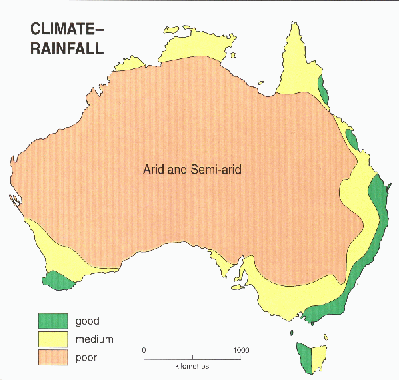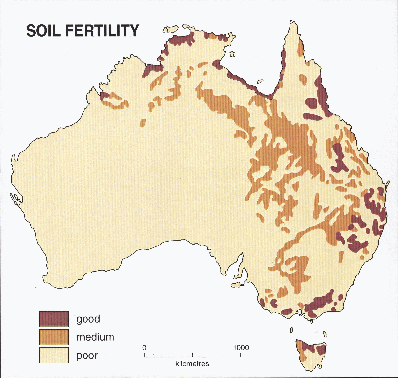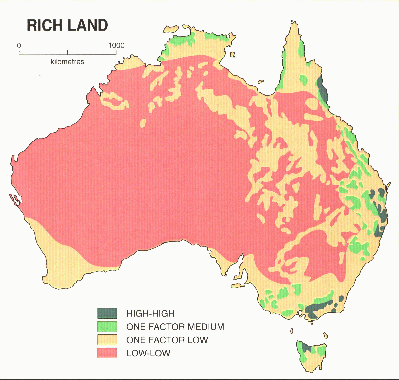mark o'connor - australian poet
Boundless Plains?
Those who talk about Australia's "boundless plains", and the vast population these ought to sustain, need to check out the maps below produced by Dr Chris Watson during his career as a CSIRO soil scientist. Chris Watson's 3 maps are shown here by permission of the author.
The first, titled Climate-Rainfall, shows in deep green those few parts of Australia that have sufficient and reliable rainfall to be ideal for agriculture. This map may not surprise those who know a bit about geography. Note that it represents not total rainfall but rainfall suitable for agriculture. Thus much of the Northern Territory has quite high rainfall, but concentrated mainly in 3 months and followed by a searing drought. Such rainfall is not very useful except in areas where large deep-water dams can be constructed.
The second map, titled Soil Fertility, makes a less obvious point. Australia's ancient continental plate has very few volcanic areas. Hence only the portions shown in darker brown have rich volcanic or alluvial soils.
But the real issue, is how much of Australia has both factors: reliable rainfall and good topsoil, such as much of the Ukraine or France has? Map three, titled Rich Land, shows (in dark blue-green) the miniscule areas that have both.
For discussion of these issues and of the maps, see Overloading Australia, pp. 6, 15, 84-88, 97. Note that maps represents the average climate of the C20th. Global warming may shift rainfall areas, and increase evaporation rates. Modelling by the ANU's Climate Change Institute and by CSIRO indicates that the areas suitable for agriculture will decrease. See for instance the maps on page 16 of
Australia’s Biodiversity and Climate Change: Summary for Policy Makers.
On the delusion that Australia is a "vast land with a small ageing population" (editorial in the Australian, 26 July 2008) see Overloading Australia pages 1, 75, 84 and 210. On the bizarre maps of Australia produced by boosters eager to show that its "gigantic inheritance" could hold more people than all the major nations of Western Europe put together, see An Historical Geography of Modern Australia by Joseph Michael Powell, pages 131 ff. (See Powell's text on Google Books).
Professor Henry Nix of the ANU's Centre for Resource and Environmental Studies estimates Australia has 77 million hectares of potentially arable land, including marginally arable --- making about 3.5 hectares of (mostly indifferent) arable land per person. From the current land use, he estimates Australia could feed about 50 million people.
However this involves maintaining the present heavy use of oil-based fertilisers that allows Australian farmers to produce crops like wheat from infertile soils. If Australian agriculture is to pay its costs, or provide net export earnings, much of the crop must continue to be exported to pay for the fertilisers and imported oil required to grow it. Very high future oil prices could make much of Australia's wheat land unviable, as could continuing erosion, salinification and acidification.


